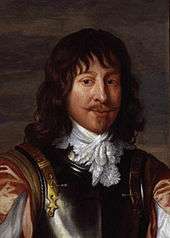Mountjoy Blount, 1st Earl of Newport

Mountjoy Blount,[1] 1st Earl of Newport (c. 1597–1666), created Baron Mountjoy in the Irish peerage (1617), baron Mountjoy of Thurveston in the English peerage (1627) and Earl of Newport (1628) was appointed master of ordnance to Charles I of England (1634) and played an ambiguous part in the early years of the English Civil War.
Life
Early career
Born around 1597, he was the natural son of Charles Blount, Earl of Devonshire and his wife, Penelope; his father left him a large estate. He became a member of James I's court, who played in a masque before the king mounted by Viscount Doncaster at Essex House, 8 January 1620/1621,[2] was among the entourage of the Earl of Carlisle, employed to offer excuses at the court of Louis XIII, for the passage of Prince Charles through Paris incognito on his way to Spain at the time of negotiations towards the ill-starred "Spanish Match".
Earl of Newport
In July 1627 he was created Earl of Newport in the Isle of Wight; Newport, as he now was, held a rear-admiral's command in the ineffective expedition to relieve La Rochelle in August 1628, for which he was petitioning for payment in the following years. His appointment as Master of Ordnance for his lifetime was granted 31 August 1634; as was expected in the seventeenth century, he derived a tidy fortune from the position. From his sale of gunpowder at exorbitant prices, through the Spanish ambassador, to supply the Spanish fleet attacking Dutch forces in September 1639, he pocketed £1000, and the King, £5000.[3]
By his own account he bargained with the ambassador to land soldiers from the Spanish fleet at Dunkirk, at thirty shillings a head, though public neutrality had been enjoined by Charles. Although at Christmas 1639, Newport participated with the King in the extravagant masque on the theme of Philogenes, royal "lover of the People",[4] with the return of the Long Parliament the next year, Newport by degrees joined the forces of opposition in the House of Lords.
The turning point came during the trial of Strafford in 1641, when Col. Lord Goring had revealed to Newport an amateurish plot of Royalist officers at Portsmouth to take London by surprise, seize the Tower and somehow rescue the king. Goring betrayed the plot to Newport, who passed on the information to John Pym, who brought it forward at the most dramatic and opportune moment, sealing Strafford's fate in the bill of attainder.
When the Civil War broke out, however, Newport served in the royalist army, and took part in the second battle of Newbury in 1644. In January 1646 he was taken prisoner and confined in London on parole.
Family
He had on 7 February 1626 married Ann Boteler, daughter of John Boteler, 1st Baron Boteler of Bramfield, by whom he had eight children:[5][6]
- Charles Blount (bur. 23 April 1631)
- Lady Henrietta Maria Blount (bapt. 16 September 1632 – bur. 1 April 1634)
- Charles Blount, Lord Blount (bapt. 10 January 1634), died young
- Lady Isabella Blount, married Nicholas Knollys and had issue
- Lady Anne Blount (1637–?), married Maj. Thomas Porter and had issue
- Mountjoy Blount, 2nd Earl of Newport (bur. 20 March 1675), called by some sources George
- Thomas Blount, 3rd Earl of Newport (bur. 4 May 1675)
- Henry Blount, 4th Earl of Newport (bur. 25 September 1679)
He died at Oxford, where he had gone to avoid the plague, leaving three surviving sons, all said to be "idiots" (i.e. mentally disabled).[7] They each inherited the title in turn, but earldom became extinct upon the death of the youngest, Henry, in 1679.
| Military offices | ||
|---|---|---|
| Preceded by The Lord Vere of Tilbury |
Master-General of the Ordnance 1634–1661 |
Succeeded by Sir William Compton |
| Peerage of England | ||
| New creation | Earl of Newport 1628–1666 |
Succeeded by Mountjoy Blount |
| Baron Mountjoy 1627–1666 | ||
| Peerage of Ireland | ||
| New creation | Baron Mountjoy 1618–1666 |
Succeeded by Mountjoy Blount |
References
-
 Chisholm, Hugh, ed. (1911). "Mountjoy, Barons and Viscounts". Encyclopædia Britannica. 18 (11th ed.). Cambridge University Press. p. 941. s.v. "Mountjoy Blount"
Chisholm, Hugh, ed. (1911). "Mountjoy, Barons and Viscounts". Encyclopædia Britannica. 18 (11th ed.). Cambridge University Press. p. 941. s.v. "Mountjoy Blount" - Dictionary of National Biography, s.v. "Mountjoy Blount"
Notes
- ↑ The name is pronounced "Blunt".
- ↑ The masque, played before the King to celebrate the arrival of the French ambassador, has been rediscovered; see Timothy Raylor, “The Lost Essex House Masque (1621): A Manuscript Text Discovered,”. English Manuscript Studies 1100–1700 7 (1998): 86–130, and "The Design and Authorship of The Essex House Masque (1621)", MRDE 10 (1998), p. 218.
- ↑
 "Blount, Mountjoy". Dictionary of National Biography. London: Smith, Elder & Co. 1885–1900.
"Blount, Mountjoy". Dictionary of National Biography. London: Smith, Elder & Co. 1885–1900. - ↑ Woodward 1955:310; almost the last of the masques, its words were by Sir William Davenant, its sets and costumes by Inigo Jones.
- ↑ Waters, Robert Edmund Chester (1878). Genealogical memoirs of the extinct family of Chester of Chicheley v. 1. London, UK: Robson & Sons. pp. 151–152.
- ↑ Accounts of his sons in peerage references tend to be inconsistent in both names and dates. Waters quotes the most extensively from parish registers.
- ↑ Collectanea topographica et genealogica. v. 6. London, UK: John Bowyer Nichols and Son. 1840. pp. 84–85.